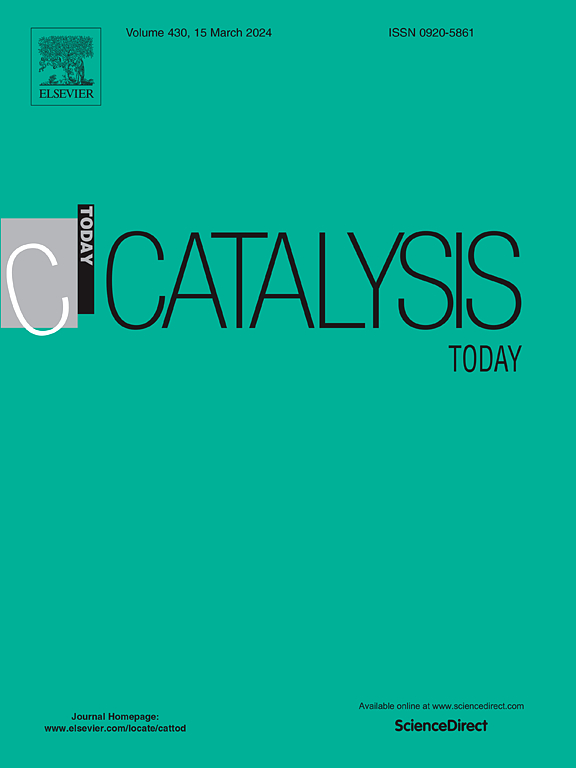Surface growth of mixed metal oxide thin rafts and their impact on methane dry reforming
IF 5.2
2区 化学
Q1 CHEMISTRY, APPLIED
引用次数: 0
Abstract
Synergistic interactions between the supported thin oxide layer and the underlying metal oxide support led to the development of novel and exciting material properties. In this work, we present a new and general approach for the surface growth of MgAl layered double hydroxides (LDH) on ZrO₂, Al₂O₃, and TiO₂ support materials. We examine the synergistic interactions between the top MgAlOx mixed metal oxide (MMO), obtained after LDH calcination, and the underlying metal oxide support (MMO/metal oxide) as a function of MMO loading and support type. The obtained materials are characterized using a range of analytical tools ICP-OES, H2-TPR, CO2-TPD, PXRD, TGA/DSC, physisorption, HRSEM-EDS and HAADF-STEM–EDS followed by catalytic testing. We show that regardless of the MMO/metal oxide combination, effective interaction between the MMO and the underlying support, more dominant at the lower MMO coverage, promotes synergistic effects, manifested by a lower Ni reduction temperature compared to Ni on bulk MMO. Evaluating the obtained catalysts (Ni/MMO/metal oxide) in the dry reforming of methane (DRM) reaction, we find that the increase in MgAlOx-MMO coating amount on the ZrO2 nanoparticles (NPs) leads to an improvement in DRM activity and stability. In addition, we find that for the same MgAlOx-MMO coating amount, the Ni catalyst based on the ZrO2 NPs is superior to the catalyst based on Al2O3 NPs, while the catalyst based on TiO2 NPs is the least active. The obtained results are explained in context to the extent of coating, metal support interaction (MSI) levels, and support structure. Combined with the high versatility of LDH material, this new methodology provides a versatile synthetic route to adapt the surface property of an oxide to a certain application. For DRM, we show the tuning of MSI as governed by the interactions between the underlying metal oxide and supported MMO.
混合金属氧化物薄筏表面生长及其对甲烷干重整的影响
支撑的薄氧化层和底层金属氧化物支撑之间的协同相互作用导致了新的和令人兴奋的材料性能的发展。在这项工作中,我们提出了一种新的和通用的方法来在ZrO₂,Al₂O₃和TiO₂载体材料上生长MgAl层状双氢氧化物(LDH)。我们研究了LDH煅烧后得到的顶部MgAlOx混合金属氧化物(MMO)与底层金属氧化物载体(MMO/金属氧化物)之间的协同相互作用,作为MMO负载和载体类型的函数。采用ICP-OES、H2-TPR、CO2-TPD、PXRD、TGA/DSC、物理吸附、HRSEM-EDS和HAADF-STEM-EDS等分析工具对所得材料进行了表征,并进行了催化测试。我们发现,无论MMO/金属氧化物组合如何,MMO与底层支撑物之间的有效相互作用,在MMO覆盖率较低时更为明显,促进了协同效应,表现为Ni在大块MMO上的还原温度低于Ni。对制备的催化剂(Ni/MMO/金属氧化物)在甲烷干重整反应(DRM)中的性能进行了评价,发现mgaloxo -MMO包覆量的增加导致了ZrO2纳米颗粒(NPs)上DRM活性和稳定性的提高。此外,我们发现在相同的MgAlOx-MMO涂层量下,基于ZrO2 NPs的Ni催化剂的活性优于基于Al2O3 NPs的催化剂,而基于TiO2 NPs的催化剂活性最低。所获得的结果在涂层、金属支撑相互作用(MSI)水平和支撑结构的范围内得到了解释。结合LDH材料的高通用性,这种新方法提供了一种通用的合成路线,可以使氧化物的表面性能适应特定的应用。对于DRM,我们展示了MSI的调优是由底层金属氧化物和支持的MMO之间的相互作用控制的。
本文章由计算机程序翻译,如有差异,请以英文原文为准。
求助全文
约1分钟内获得全文
求助全文
来源期刊

Catalysis Today
化学-工程:化工
CiteScore
11.50
自引率
3.80%
发文量
573
审稿时长
2.9 months
期刊介绍:
Catalysis Today focuses on the rapid publication of original invited papers devoted to currently important topics in catalysis and related subjects. The journal only publishes special issues (Proposing a Catalysis Today Special Issue), each of which is supervised by Guest Editors who recruit individual papers and oversee the peer review process. Catalysis Today offers researchers in the field of catalysis in-depth overviews of topical issues.
Both fundamental and applied aspects of catalysis are covered. Subjects such as catalysis of immobilized organometallic and biocatalytic systems are welcome. Subjects related to catalysis such as experimental techniques, adsorption, process technology, synthesis, in situ characterization, computational, theoretical modeling, imaging and others are included if there is a clear relationship to catalysis.
 求助内容:
求助内容: 应助结果提醒方式:
应助结果提醒方式:


